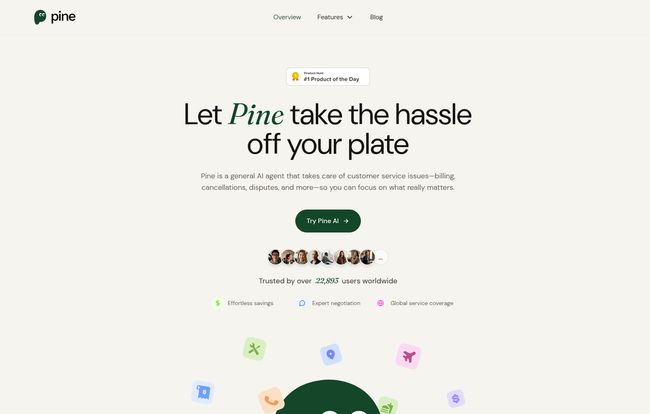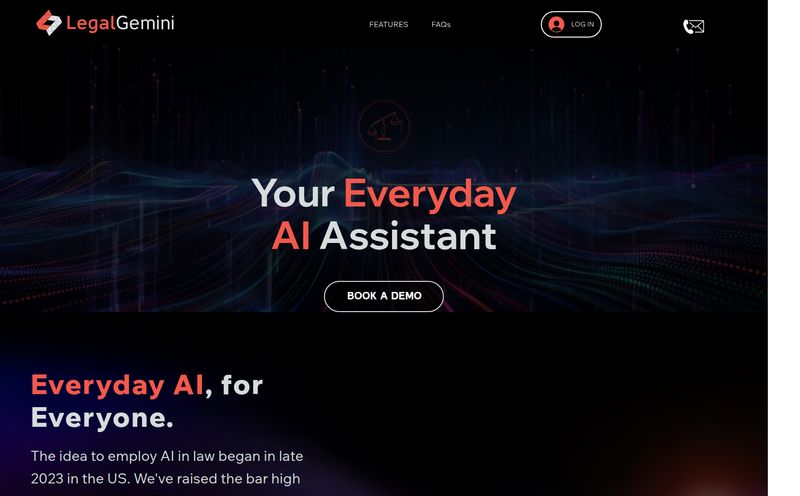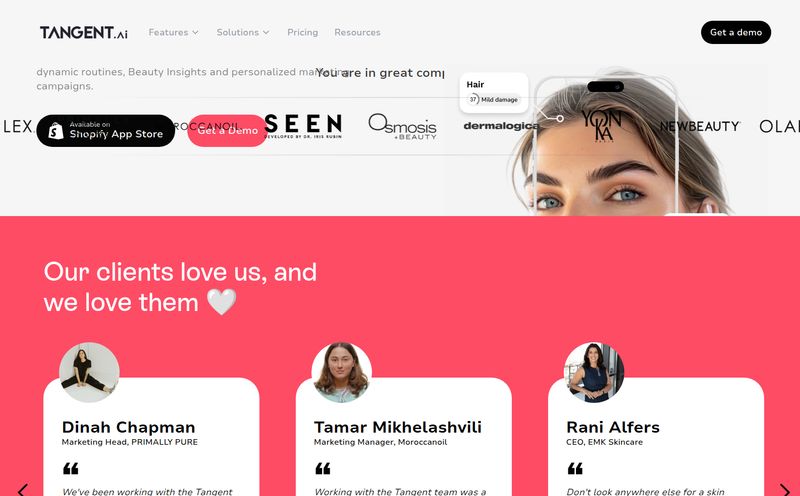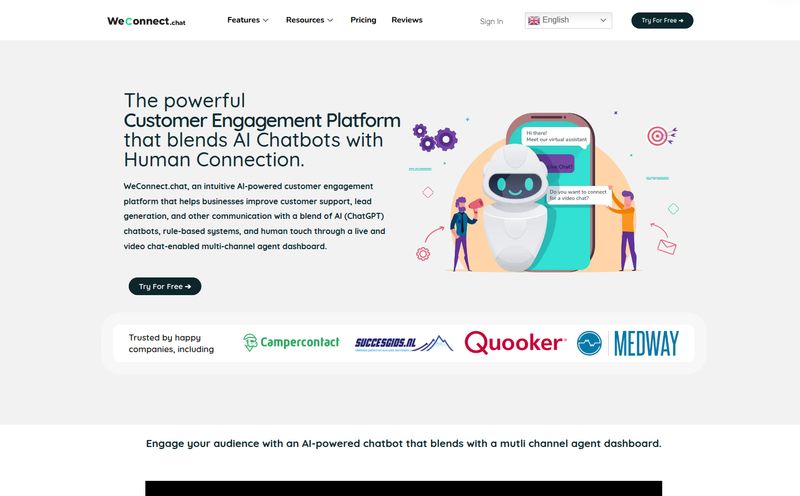There are few things in this world more soul-crushing than the jaunty, tinny tune of customer service hold music. It’s the soundtrack to our collective frustration. I swear, I’ve lost entire afternoons of my life listening to a MIDI version of a song I didn't even like in the first place, just waiting to argue about a $10 overcharge on my internet bill.
We’ve all been there. You navigate a labyrinth of automated menus (“Press 1 for sales. Press 2 for support. Press 7 to question your life choices.”), finally get a human, and then have to retell your story three different times as you get transferred. It’s a modern-day torture device.
So when I stumbled across a tool called Pine AI, my inner cynic and my exhausted inner consumer both sat up and paid attention. The premise is so simple, it’s almost brazen: an AI assistant that handles all those annoying phone calls for you. Bill negotiations, subscription cancellations, disputes... all of it. Could this be real? Or was it just another tech-bro fever dream? I had to check it out.
So, What on Earth is Pine AI?
At its core, Pine AI is your own personal AI advocate. Think of it as a digital bulldog you can send into the customer service arena on your behalf. You give it the mission—say, lowering your Xfinity bill or canceling that AT&T plan you no longer need—and it goes to work, making the actual phone call so you don't have to.
It's designed to take the hassle, as they say, “off your plate.” And looking at the companies they're ready to call—big names like Verizon, Comcast, and T-Mobile—it's clear they’re targeting the biggest sources of our collective call-waiting pain.

Visit Pine AI
But it's not just about waiting on hold. The platform claims to use data-driven negotiation strategies. This is what really caught my eye as a tech guy. It suggests the AI isn't just mindlessly reading a script. It’s supposedly analyzing your bill for hidden fees, comparing your rates to others, and using actual data to build a case for you. It's like sending a tiny, hyper-focused lawyer to do your bidding.
A Peek Behind the Curtain: The Pine AI Process
The whole process seems pretty straightforward. You sign up, connect a payment method (more on that in a sec), and create a task. You tell Pine what the problem is, provide the necessary account details, and set it loose. No phone calls, no hold music, no repeating your account number for the fifth time.
The AI then gets to work. When it’s all over, you get a summary of the conversation and, hopefully, a resolution. They even provide an audio recording of the call, which is a fantastic touch for transparency. You can literally hear your little AI assistant fighting for you.
Okay, But What Does It Cost? The Pricing Model is… Different
This is where Pine AI goes from “interesting” to “wait, really?” Most services like this would have a monthly subscription or a hefty flat fee. Not Pine. Their model is built on three pillars, and it’s one of the most user-friendly approaches I’ve seen in a while.
- Pay As You Go: There's no subscription. You use it when you need it. Before it starts a task, you set a custom tip amount based on what the successful resolution is worth to you. If getting a $50 refund is worth a $10 tip, you set that. It’s entirely up to you.
- Secure Payment: They place a pre-authorization hold on your card for the tip amount. If the task isn’t completed within a week, the hold is just... released. No charge. No hassle.
- Only Pay When It Works: This is the killer feature. If Pine AI doesn't succeed—if it can't lower your bill or cancel that subscription—you pay nothing. Zero. The pre-auth hold is released, and you owe them zilch.
Let me just say that again. You only pay if it actually works. This risk-free model shows a ton of confidence in their product. It completely removes the hesitation to try it, because what have you got to loose? A few minutes of setup? I've spent more time than that trying to find the right number to call my bank.
The Good, The Not-So-Good, and The AI Reality
No tool is perfect, of course. As a professional blogger in this space, I’ve learned to look at every new shiny object with a healthy dose of skepticism. So let’s break it down.
Why I'm Genuinely Impressed
The biggest pro is obvious: time. The hours you get back are invaluable. But it's also about mental energy. Not having to psych yourself up for a potentially confrontational call is a huge weight off your shoulders. The potential to lower bills and eliminate sneaky fees is the financial cherry on top. And the fact that it's all backed by data-driven strategies and secured with end-to-end encryption gives it a layer of legitimacy that's really comforting when you're handing over account info.
A Few Things to Keep in Mind
On the flip side, you're placing your trust in an AI. While it might be great for straightforward negotiations, a really complex, unique, or emotionally charged issue might still need a human touch. The system's effectiveness is entirely dependent on how good the AI is at communicating and how well it can adapt to a human agent's curveballs.
Also, the old rule of “garbage in, garbage out” applies here. If you provide incomplete or inaccurate information about your problem, you can’t expect the AI to work miracles. The onus is still on you to give it a clear and accurate brief.
The Final Verdict: Is Pine AI Your New Best Friend?
So, is it worth it? In my opinion, for the vast majority of common customer service headaches, absolutely. Think about it. Who is this for? It’s for the busy professional who bills by the hour and can't justify spending 90 minutes to save $15. It's for the person with social anxiety who dreads confrontation. It’s for anyone who looks at their to-do list and thinks, “I would pay someone to just make this problem go away.”
Pine AI is essentially that someone. A specialized, one-off virtual assistant for life's most annoying administrative tasks. Given the “pay only if it works” model, trying it out is a no-brainer. At worst, you're exactly where you started. At best, you’ve saved money, and more importantly, you’ve reclaimed a piece of your day and your sanity. And in today’s world, you can’t really put a price on that.
Frequently Asked Questions about Pine AI
- How does Pine AI actually make money?
- Pine AI operates on a tip-based model. You only pay a tip that you set yourself, and only if the AI successfully resolves your issue. If there's no result, there's no charge.
- Is it safe to give my personal information to Pine AI?
- According to their website, they take security seriously. Pine AI uses end-to-end encryption for your data and only uses it for the specific task you've assigned. Plus, providing call recordings adds a layer of transparency.
- What happens if Pine AI fails to solve my problem?
- Nothing! If Pine AI is unsuccessful, you are not charged. The pre-authorization hold on your payment method is simply released. It's a completely risk-free process.
- What kinds of tasks can Pine AI handle?
- It's designed for a wide range of common customer service issues, including negotiating to lower bills (like cable or internet), canceling subscriptions, disputing charges, getting refunds from airlines, and even handling some interactions with the DMV.
- Do I have to talk to anyone on the phone?
- Nope! That's the whole point. You delegate the task through their platform, and the AI makes the call for you. You just get the results afterward.
- Can I listen to the calls Pine AI makes for me?
- Yes, Pine AI provides audio recordings of the calls it handles, so you can review the entire conversation and confirm how the resolution was reached.
Conclusion
Tools like Pine AI feel like the future of personal administration. We're slowly but surely getting to a point where we can outsource the most tedious parts of our lives to smart, efficient AI. While it may not be able to solve every single problem, it’s a massive step in the right direction. For anyone tired of the customer service runaround, Pine AI isn't just a neat tool—it's a breath of fresh, hassle-free air.



